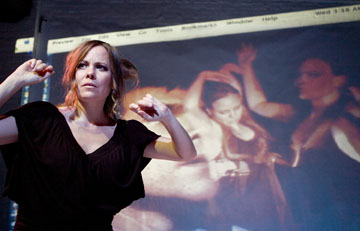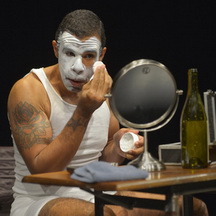
The brain—frontal lobes and all …
How the brain works—how it sorts things, compiles memories, discriminates, and applies past to future—is of utmost importance in this world in which war and death are the frequent penalties of misunderstanding and habitual intolerance. How to approach that subject is a worthwhile endeavor and the focus, considered generously, of Sara Kraft’s performance piece, HyperReal, which premiered at the Yerba Buena Center on Thursday.
Kraft takes a central metaphor—that of her experience of the movie Jaws when she was four years old—and traces it through other events in her life and that of the surrounding world. The four-year-old’s vision of the attacking shark becomes a vector for fear, and the medium of the ocean becomes a metaphor for the subconscious in which lurk unknowable and dangerous presences. Her mind becomes a “shark-infested ocean.”
From here, the audience is taken through a series of stories that are all linked to how the mind parses reality and makes it into its own reality. The consequences of the mind’s habitual recreation of reality are also touched on: most effectively in the piece’s one truly transfixing sequence: the description of the military drones run by computer operators, which bomb Iraq and Afghanistan.
Kraft holds the audience’s attention primarily through two sets of images projected on a screen. The first set is comprised of underwater scenes with single and multiple sharks swaying through shifting blue light. The second set is of Kraft’s face hugely projected on the screen, larger than any experienced typically in movie houses.
First, on the audience side of the screen, we see her telling her traumatic stories to a camera, which then projects her face on the screen. Then she moves to the back of the screen where we see her moving forward and backward, dance like, while talking to the camera, her face projected in multiples that overlap, shrink and grow.
There are other images as well: a 29-year-old man, who appears to be making a video of himself for a dating service, tries over and over to tell the story of his personality only to fail finally and drop into silence. The dancer who has been moving, more or less invisibly, to the side of the stage throughout the performance is suddenly projected in a series of abstract and visually vibrant silhouettes. At one point, the letters Kraft types into her computer—“How are you?” “I’m good … ok … better …” etc.—appear white on black on the screen. A mélange of all the images frantically stirs itself in a rising climax of dread.
The artist front and center
As the young student behind me observed in a pre-performance conversation to the woman next to him, “Performance is all about you.” Like most art, it is the product of a single person, a delineation of that individual’s perceptions of the world, crafted in idiosyncratic ways. That is both its virtue and its vice.
Virtue because what it reveals is true. It belongs, like it or not, to the artist and therefore its content is undeniable.
Vice because what is shown may or may not be of any interest to anyone outside of the artist, and even if it is of interest, the presence of the artist can often be a barrier to the viewer’s experience.
Kraft’s two-hour performance needed serious editing. It needed to be a good half hour shorter than it was. Concision is a greater virtue in art. And although the individual sequences were interesting in themselves, they needed to be better woven together so that they didn’t seem merely like the artist running through a laundry list of related observations. The impact in this piece was almost always misplaced.
Likewise with the imagery. It’s not entirely clear why Kraft’s face needed to be there, most of the time, continuously, like some oblivious version of Big Brother.
—Jaime Robles
Photo: Sara Kraft in ‘HyperReal’. Copyright by Lydia Daniller
